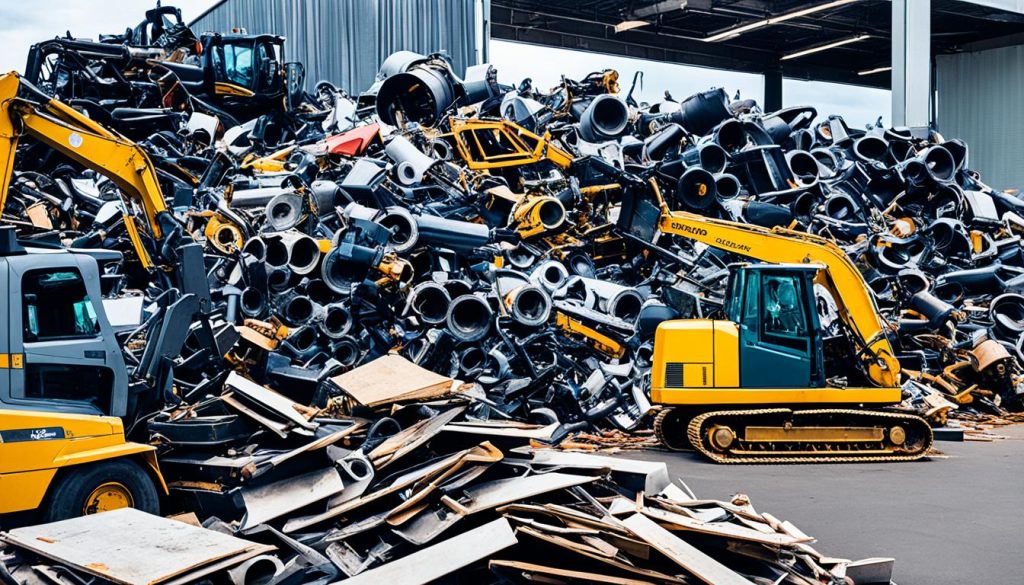Welcome to our comprehensive guide on Business Asset Disposal Relief (BADR), a valuable relief for entrepreneurs in the United Kingdom. BADR is a Capital Gains Tax (CGT) relief that reduces the rate of tax paid on the disposal of business assets. This relief is designed to support and incentivize business growth by allowing individuals and trustees to pay a reduced rate of 10% on qualifying disposals.
When it comes to CGT, it is crucial for entrepreneurs to understand the ins and outs of BADR. This relief applies to various qualifying disposals, including sole trades, partnership interests, shares in your own company, and joint venture interests. However, there are conditions to meet and rules to follow.
In our upcoming sections, we will delve deeper into BADR, explaining what it is, how to claim it, the qualifying assets, the limits and conditions, anti-avoidance measures, and provide a practical example. Stay tuned as we navigate the intricacies of BADR and help you make the most of this valuable relief.
What is Business Asset Disposal Relief?
Business Asset Disposal Relief (BADR), previously known as Entrepreneurs’ Relief, is a Capital Gains Tax (CGT) relief designed to reduce the tax burden on the disposal of business assets. It is available to individuals and trustees, providing them with the opportunity to pay a reduced rate of just 10% on qualifying disposals. BADR applies to various types of business assets, including sole trades, partnership interests, shares in one’s own company, and joint venture interests.
Previously known as Entrepreneurs’ Relief, this CGT relief has undergone a rebranding to better reflect its purpose, which is to incentivize entrepreneurial activity by reducing the tax liability associated with the disposal of business assets. The relief aims to reward individuals who have invested their time, effort, and capital into building a successful business.
To claim a BADR, individuals and trustees must satisfy certain conditions set by HMRC. This includes meeting the eligibility requirements for CGT and making a qualifying disposal of business assets. The relief has a lifetime limit of £1 million, which means individuals can benefit from the reduced 10% rate of CGT up to this limit. Any gains exceeding the lifetime limit will be subject to the standard CGT rates applicable for that period.

How to Claim Business Asset Disposal Relief?
To claim Business Asset Disposal Relief (BADR), individuals must meet certain conditions. They must be eligible for Capital Gains Tax (CGT) and have made a qualifying disposal of business assets. The disposal must meet the conditions specified by HMRC, including being a material disposal of business assets or an associated disposal.
Individuals can claim BADR by reporting the disposal on their personal tax return and applying the appropriate rate of 10% to the qualifying gains. It is important to meet all the conditions and provide accurate information when claiming BADR.
Here are the steps to claim Business Asset Disposal Relief:
- Determine if you are eligible for Capital Gains Tax (CGT).
- Ensure that your disposal of business assets meets the conditions specified by HMRC.
- Report the disposal on your personal tax return.
- Apply the rate of 10% to the qualifying gains to calculate the amount of relief.
- Provide accurate information and supporting documentation to HMRC when claiming BADR.
By following these steps and meeting all the necessary conditions, you can successfully claim Business Asset Disposal Relief and benefit from the reduced rate of CGT.
Example:
Let’s consider a hypothetical scenario to illustrate how to claim Business Asset Disposal Relief:
- John, a sole trader, decides to sell business assets for a total gain of £500,000.
- John meets the eligibility criteria for Capital Gains Tax.
- The disposal of John’s business assets qualifies for Business Asset Disposal Relief according to the conditions set by HMRC.
- John reports the disposal on his personal tax return and applies the rate of 10% to calculate his relief.
- As a result, John is eligible for a reduced rate of CGT, paying £50,000 instead of £100,000 (at the standard rate) on his qualifying gains.
Claiming Business Asset Disposal Relief can have significant tax advantages for entrepreneurs, reducing the amount of CGT paid on qualifying disposals of business assets. However, it is crucial to carefully review the conditions set by HMRC and provide accurate information to ensure compliance with the guidelines.
Conditions for Claiming Business Asset Disposal Relief
| Condition | Description |
|---|---|
| Eligibility for CGT | Be eligible for Capital Gains Tax (CGT) in the UK. |
| Qualifying Disposal | Make a qualifying disposal of business assets, meeting the conditions specified by HMRC. |
| Reporting | Report the disposal on your personal tax return. |
| Applying the Rate | Apply the appropriate rate of 10% to the qualifying gains to calculate the amount of relief. |
| Accurate Information | Provide accurate information and supporting documentation when claiming BADR. |
Qualifying Assets for Business Asset Disposal Relief
Business Asset Disposal Relief (BADR) provides relief for various qualifying assets. To claim BADR, the assets involved must meet certain criteria set by HMRC. The qualifying assets for BADR include:
- The whole or part of a sole trade or partnership business
- Assets used in a business when it ceases to be carried on
- Shares or securities in a company
To qualify for BADR, the business assets must be used in the business for a certain period of time, and ownership conditions must be met. This ensures that the relief is granted for genuine business purposes. It is important for entrepreneurs to carefully assess their assets and determine if they meet the necessary criteria to claim for BADR.
For example, let’s consider a scenario where an individual has owned and used a property solely for their business purposes for a continuous period of five years. Upon ceasing the business and disposing of the property, they may be eligible for BADR on the gains made from the disposal, subject to meeting all the qualifying asset requirements.
Qualifying Assets for Business Asset Disposal Relief – Summary
| Qualifying Assets |
|---|
| The whole or part of a sole trade or partnership business |
| Assets used in a business when it ceases to be carried on |
| Shares or securities in a company |
By carefully evaluating whether their assets meet the qualifying criteria, entrepreneurs can take advantage of Business Asset Disposal Relief and benefit from the reduced rate of tax on qualifying disposals.

Business Asset Disposal Relief Limit and Conditions
Business Asset Disposal Relief (BADR) offers entrepreneurs in the UK a valuable opportunity to reduce their capital gains tax (CGT) liability on qualifying disposals of business assets. This relief comes with certain limits and conditions that individuals must meet to take advantage of its benefits.
Limit on Qualifying Capital Gains
BADR has a lifetime limit of £1 million on qualifying capital gains. This means that individuals can claim BADR for the qualifying gains up to this limit and pay a reduced rate of 10% on those gains. Any gains exceeding the lifetime limit will be subject to the normal CGT rates applicable for that period.
Conditions for Claiming BADR
To be eligible for BADR, individuals must meet the following conditions:
- Eligibility for CGT: Individuals must qualify for CGT and have the necessary tax liability.
- Qualifying Disposal: The disposal of business assets must meet the conditions specified by HMRC. This includes being a material disposal of business assets or an associated disposal.
- Accurate Information: Individuals must provide accurate information when reporting the disposal and claiming BADR.

Understanding the limit and conditions of BADR is crucial for entrepreneurs looking to optimize their tax liability. By staying within the lifetime limit and ensuring compliance with HMRC regulations, individuals can benefit from the reduced CGT rate and maximize their tax savings.
Business Asset Disposal Relief Anti-Avoidance Measures
To prevent abuse and ensure that Business Asset Disposal Relief (BADR) is claimed for genuine business purposes, HMRC has implemented anti-avoidance measures. These measures aim to identify and prevent any attempts to artificially structure transactions to take advantage of BADR. Taxpayers must comply with the rules and conditions set by HMRC to qualify for BADR, and any attempts to abuse the relief may result in penalties or the denial of the relief. It is important to understand and adhere to the anti-avoidance measures to ensure compliance with HMRC regulations.

Business Asset Disposal Relief Example
Understanding how Business Asset Disposal Relief (BADR) works can be best illustrated by a practical example:
Case Study: Sarah’s Business Disposal
Sarah is a successful entrepreneur who has built a thriving IT consulting business over the years. As she approaches retirement, Sarah decides it’s time to sell her business and enjoy the fruits of her labor.
She has invested significant time, effort, and capital into her business, and wants to maximize her return while minimizing the tax liability. This is where Business Asset Disposal Relief comes into play.
In the process of selling her business, Sarah meets all the eligibility requirements for BADR. She has been eligible for Capital Gains Tax (CGT) throughout the ownership of her business, ensuring she meets the first condition for claiming the relief.
After assessing the value of her business and consulting with her tax advisor, Sarah determines that the total capital gains from the disposal of her business assets amount to £800,000.
Given that the lifetime limit for BADR is £1 million, Sarah qualifies for the full relief on her capital gains.
With the relief applied, Sarah’s taxable gain of £800,000 is subject to the reduced CGT rate of 10% instead of the standard rate. This results in a tax liability of £80,000, significantly lower than what it would have been without BADR.
Thanks to the Business Asset Disposal Relief, Sarah can enjoy a substantial tax saving on the disposal of her business assets, allowing her to safeguard her hard-earned profits and provide a stronger financial foundation for her retirement.
BADR can be a game-changer for entrepreneurs like Sarah, enabling them to optimize their tax position and make the most of their business exit strategies.
However, it’s crucial to note that each case is unique, and the tax implications can vary depending on individual circumstances. Seeking professional advice from qualified tax experts is always recommended to ensure compliance with HMRC regulations and make informed decisions regarding Business Asset Disposal Relief.
Conclusion
Business Asset Disposal Relief (BADR) is a valuable relief for entrepreneurs in the UK. It provides a significant reduction in the rate of Capital Gains Tax (CGT) paid on qualifying disposals of business assets, lowering it to just 10%. This relief offers a great opportunity for individuals to maximize their returns when selling or disposing of their business assets.
To claim BADR, it is essential to meet certain conditions and accurately report the disposal. Familiarizing yourself with the qualifying assets, limits, and conditions set by HMRC is crucial for a successful claim. Additionally, using tools such as the Business Asset Disposal Relief Calculator can help you determine the potential relief you may be eligible for.
It’s always advisable to refer to the HMRC manual for comprehensive guidance on claiming Business Asset Disposal Relief. The manual provides detailed information on the rules and regulations surrounding the relief, enabling you to ensure compliance and make the most of this valuable tax relief.
By taking advantage of Business Asset Disposal Relief, entrepreneurs can optimize their tax strategies and keep more of their hard-earned profits. Understanding the requirements, consulting the HMRC manual, and utilizing the calculator tools are all integral parts of claiming this relief and maximizing its benefits.





